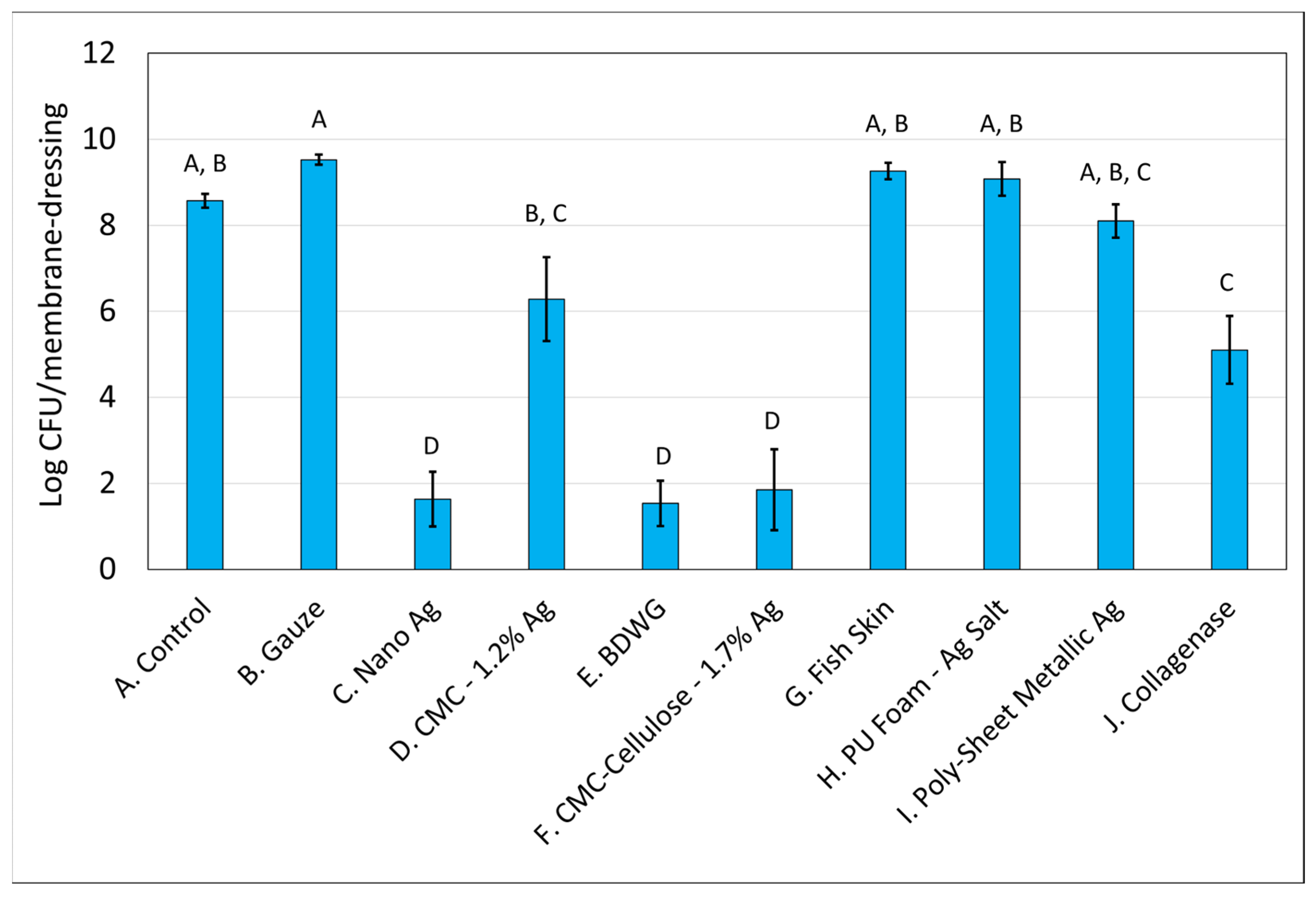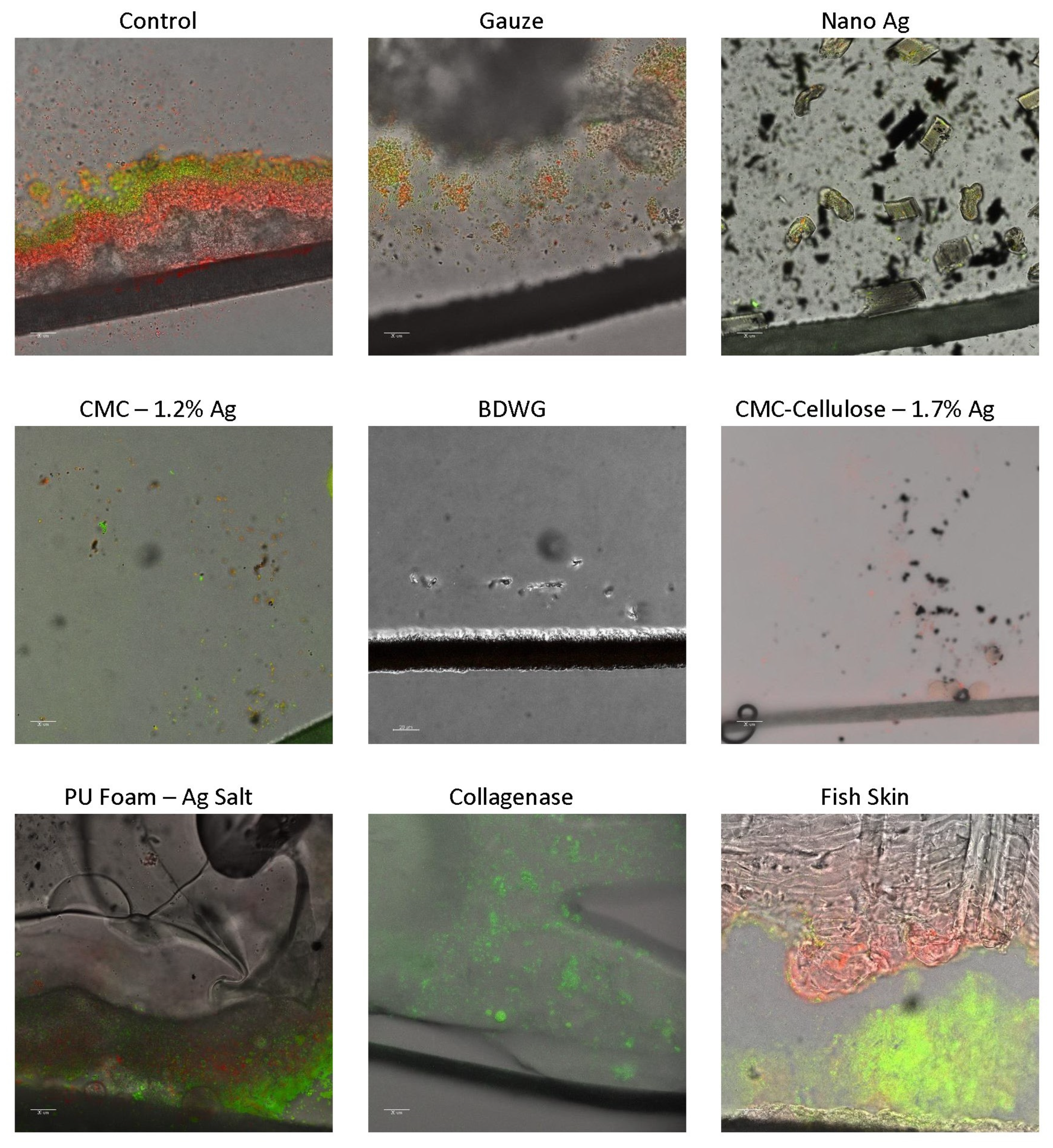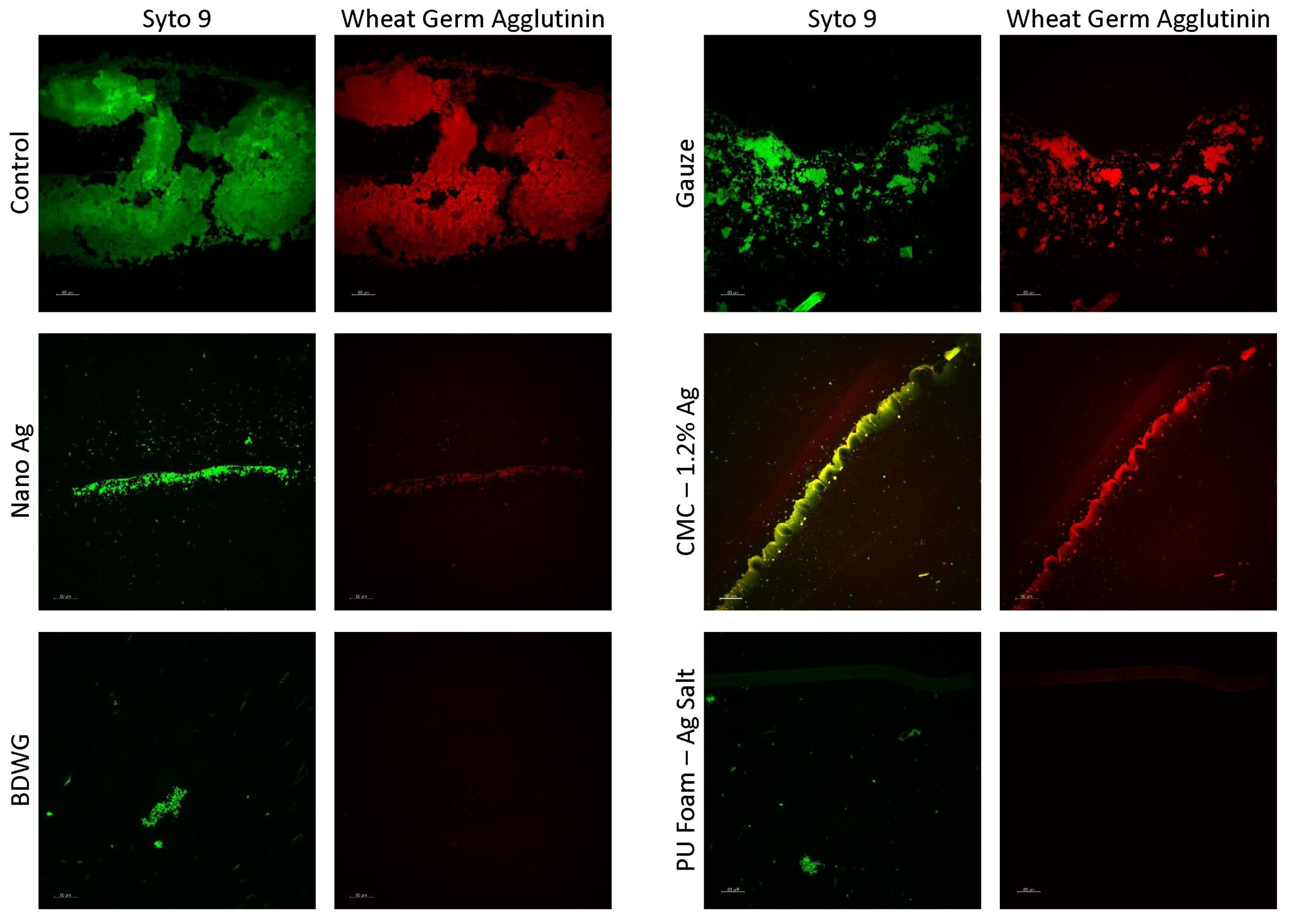Anti-Biofilm Efficacy of Commonly Used Wound Care Products in In Vitro Settings
Abstract
1. Introduction
2. Results
2.1. Efficacy of Wound Care Products in Preventing the Formation of New Biofilm in a CDFR Determined by Viable Plate Count
2.2. Efficacy of Wound Care Products in Preventing the Formation of New Biofilm in a CDFR Determined by CSLM Imaging
2.3. Efficacy of Wound Care Products in Treating Established Mixed-Species DFR Biofilm by Viable Plate Count
3. Discussion
4. Materials and Methods
- A.
- Control: Mixed species inoculate left untreated.
- B.
- Gauze: Saline saturated gauze was used to simulate sham treatment.
- C.
- Nano Ag: An antimicrobial barrier dressing with a nanocrystalline coating of silver that rapidly kills a broad spectrum of bacteria in as little as 30 min. It consists of three layers: an absorbent inner core sandwiched between outer layers of silver coated, low adherent polyethylene net. Nanocrystalline Silver protects the wound site from bacterial colonization while the inner core helps maintain a moist wound environment.
- D.
- CMC-1.2% Ag: The product is a silver-impregnated, antimicrobial, absorbent, sterile, non-woven hydroentangled dressing comprised of Hydrofiber (sodium carboxymethylcellulose). The dressing contains 1.2% w/w ionic silver. The silver in the dressing kills a broad spectrum of wound bacteria.
- E.
- BDWG: The product is an antimicrobial wound gel made from citric acid (3.41%) sodium citrate (3.57%), benzalkonium chloride (0.13%), polyethylene glycol, and water buffered to a pH of 4 at an osmolarity of 2330 mOsm/L. The gel provides wound management by maintaining a moist wound environment conducive to wound healing. While in place, the gel can chelate metal ions from EPS causing its disruption and remove proteins from bacterial cell membranes causing their lysis.
- F.
- CMC-Cellulose-1.7% Ag: The product is a non-woven dressing made of sodium carboxymethylcellulose (CMC), cellulose fibers, and silver oxysalts (0.2 mg Ag/cm2) (1.7 wt./wt.). The dressing reportedly kills at least 99.999% of a broad spectrum of bacteria, kills bacteria within a biofilm, and prevents biofilm reformation.
- G.
- Fish Skin: The product is composed of intact fish skin and FDA coded as a skin substitute. The intact decellularized fish skin is used for the management of chronic wounds such as diabetic wounds, pressure ulcers, vascular ulcers, and draining wounds. The fish skin sheets contain fat, protein, elastin, glycans, and other natural skin elements.
- H.
- PU Foam-Ag Salt: The product is an absorbent dressing made from Polyurethane foam. The outer surface of the foam is bonded to a vapor-permeable PU membrane and contains a silver salt that disperses into the wound fluid and is designed for the management of low to moderately exuding wounds. It may be used on infected wounds. The product has fast (from 30 min, in vitro), sustained (up to 7 days, in vitro), and broad range antimicrobial action (in vitro).
- I.
- Poly-Sheet Metallic Ag: The product is a thin-film polymeric sheet composed of polyelectrolyte and polyvinyl alcohol containing ionic and metallic silver. The nanofilm matrix contains a low level of ionic and metallic silver (<25 µg/sq cm) to prevent microbial contamination and colonization of the matrix.
- J.
- Collagenase: The product is an enzymatic debridement agent composed of an exogenous bacterial collagenase derived from fermentation by Clostridium histolyticum, with a pH of 6–8. The mechanism of action involves impacting necrotic tissue by cleaving at multiple sites of denatured collagen molecules and effectively removing barriers to healing, enabling wound progression by creating polypeptide bioactive byproducts.
5. Conclusions
Author Contributions
Funding
Institutional Review Board Statement
Informed Consent Statement
Data Availability Statement
Conflicts of Interest
References
- Percival, S.L.; McCarty, S.M.; Lipsky, B. Biofilms and Wounds: An Overview of the Evidence. Adv. Wound Care 2015, 4, 373–381. [Google Scholar] [CrossRef] [PubMed]
- Zhao, G.; Usui, M.L.; Lippman, S.I.; James, G.A.; Stewart, P.S.; Fleckman, P.; Olerud, J.E. Biofilms and Inflammation in Chronic Wounds. Adv. Wound Care 2013, 2, 389–399. [Google Scholar] [CrossRef] [PubMed]
- Johani, K.; Malone, M.; Jensen, S.; Gosbell, I.; Dickson, H.; Hu, H.; Vickery, K. Microscopy Visualisation Confirms Multi-Species Biofilms Are Ubiquitous in Diabetic Foot Ulcers: Biofilms in DFUs. Int. Wound J. 2017, 14, 1160–1169. [Google Scholar] [CrossRef] [PubMed]
- Watters, C.; Fleming, D.; Bishop, D.; Rumbaugh, K.P. Host Responses to Biofilm. In Progress in Molecular Biology and Translational Science; Elsevier: Amsterdam, The Netherlands, 2016; Volume 142, pp. 193–239. [Google Scholar] [CrossRef]
- Thi, M.T.T.; Wibowo, D.; Rehm, B.H.A. Pseudomonas aeruginosa Biofilms. Int. J. Mol. Sci. 2020, 21, 8671. [Google Scholar] [CrossRef]
- Schilcher, K.; Horswill, A.R. Staphylococcal Biofilm Development: Structure, Regulation, and Treatment Strategies. Microbiol. Mol. Biol. Rev. 2020, 84, e00026-19. [Google Scholar] [CrossRef]
- Vestby, L.K.; Grønseth, T.; Simm, R.; Nesse, L.L. Bacterial Biofilm and Its Role in the Pathogenesis of Disease. Antibiotics 2020, 9, 59. [Google Scholar] [CrossRef]
- Jamal, M.; Ahmad, W.; Andleeb, S.; Jalil, F.; Imran, M.; Nawaz, M.A.; Hussain, T.; Ali, M.; Rafiq, M.; Kamil, M.A. Bacterial Biofilm and Associated Infections. J. Chin. Med. Assoc. 2018, 81, 7–11. [Google Scholar] [CrossRef]
- Sharma, D.; Misba, L.; Khan, A.U. Antibiotics versus Biofilm: An Emerging Battleground in Microbial Communities. Antimicrob. Resist. Infect. Control 2019, 8, 76. [Google Scholar] [CrossRef]
- Høiby, N.; Bjarnsholt, T.; Givskov, M.; Molin, S.; Ciofu, O. Antibiotic Resistance of Bacterial Biofilms. Int. J. Antimicrob. Agents 2010, 35, 322–332. [Google Scholar] [CrossRef]
- Verderosa, A.D.; Totsika, M.; Fairfull-Smith, K.E. Bacterial Biofilm Eradication Agents: A Current Review. Front. Chem. 2019, 7, 824. [Google Scholar] [CrossRef]
- Keren, I.; Kaldalu, N.; Spoering, A.; Wang, Y.; Lewis, K. Persister Cells and Tolerance to Antimicrobials. FEMS Microbiol. Lett. 2004, 230, 13–18. [Google Scholar] [CrossRef] [PubMed]
- Schultz, G.; Bjarnsholt, T.; James, G.A.; Leaper, D.J.; McBain, A.J.; Malone, M.; Stoodley, P.; Swanson, T.; Tachi, M.; Wolcott, R.D.; et al. Consensus Guidelines for the Identification and Treatment of Biofilms in Chronic Nonhealing Wounds: Guidelines for Chronic Wound Biofilms. Wound Repair Regen. 2017, 25, 744–757. [Google Scholar] [CrossRef] [PubMed]
- Fux, C.A.; Costerton, J.W.; Stewart, P.S.; Stoodley, P. Survival Strategies of Infectious Biofilms. Trends Microbiol. 2005, 13, 34–40. [Google Scholar] [CrossRef] [PubMed]
- Parnham, A.; Bousfield, C. The Influence of Matrix Metalloproteases and Biofilm on Chronic Wound Healing: A Discussion. Br. J. Community Nurs. 2018, 23 (Suppl. S3), S22–S29. [Google Scholar] [CrossRef] [PubMed]
- Koivisto, L.; Heino, J.; Häkkinen, L.; Larjava, H. Integrins in Wound Healing. Adv. Wound Care 2014, 3, 762–783. [Google Scholar] [CrossRef] [PubMed]
- Kiecolt-Glaser, J.K.; Marucha, P.T.; Mercado, A.M.; Malarkey, W.B.; Glaser, R. Slowing of Wound Healing by Psychological Stress. Lancet 1995, 346, 1194–1196. [Google Scholar] [CrossRef]
- Atkin, L.; Bućko, Z.; Montero, E.C.; Cutting, K.; Moffatt, C.; Probst, A.; Romanelli, M.; Schultz, G.S.; Tettelbach, W. Implementing TIMERS: The Race against Hard-to-Heal Wounds. J. Wound Care 2019, 28 (Suppl. S3a), S1–S50. [Google Scholar] [CrossRef]
- Masako, K.; Hideyuki, I.; Shigeyuki, O.; Zenro, I. A Novel Method to Control the Balance of Skin Microflora. J. Dermatol. Sci. 2005, 38, 197–205. [Google Scholar] [CrossRef]
- Di Martino, P. Extracellular Polymeric Substances, a Key Element in Understanding Biofilm Phenotype. AIMS Microbiol. 2018, 4, 274–288. [Google Scholar] [CrossRef]
- Miller, K.G.; Tran, P.L.; Haley, C.L.; Kruzek, C.; Colmer-Hamood, J.A.; Myntti, M.; Hamood, A.N. Next Science Wound Gel Technology, a Novel Agent That Inhibits Biofilm Development by Gram-Positive and Gram-Negative Wound Pathogens. Antimicrob. Agents Chemother. 2014, 58, 3060–3072. [Google Scholar] [CrossRef]
- Lebeaux, D.; Chauhan, A.; Rendueles, O.; Beloin, C. From in Vitro to in Vivo Models of Bacterial Biofilm-Related Infections. Pathogens 2013, 2, 288–356. [Google Scholar] [CrossRef] [PubMed]
- Bédard, E.; Prévost, M.; Déziel, E. Pseudomonas aeruginosa in Premise Plumbing of Large Buildings. MicrobiologyOpen 2016, 5, 937–956. [Google Scholar] [CrossRef] [PubMed]
- Yin, W.; Wang, Y.; Liu, L.; He, J. Biofilms: The Microbial “Protective Clothing” in Extreme Environments. Int. J. Mol. Sci. 2019, 20, 3423. [Google Scholar] [CrossRef] [PubMed]
- Slade, E.A.; Thorn, R.M.S.; Young, A.; Reynolds, D.M. An in Vitro Collagen Perfusion Wound Biofilm Model; with Applications for Antimicrobial Studies and Microbial Metabolomics. BMC Microbiol. 2019, 19, 310. [Google Scholar] [CrossRef] [PubMed]
- Costerton, J.W. The Etiology and Persistence of Cryptic Bacterial Infections: A Hypothesis. Clin. Infect. Dis. 1984, 6 (Suppl. S3), S608–S616. [Google Scholar] [CrossRef]
- Donlan, R.M. Biofilms: Microbial Life on Surfaces. Emerg. Infect. Dis. 2002, 8, 881–890. [Google Scholar] [CrossRef]
- Bester, E.; Kroukamp, O.; Wolfaardt, G.M.; Boonzaaier, L.; Liss, S.N. Metabolic Differentiation in Biofilms as Indicated by Carbon Dioxide Production Rates. Appl. Environ. Microbiol. 2010, 76, 1189–1197. [Google Scholar] [CrossRef]
- Gebreyohannes, G.; Nyerere, A.; Bii, C.; Sbhatu, D.B. Challenges of Intervention, Treatment, and Antibiotic Resistance of Biofilm-Forming Microorganisms. Heliyon 2019, 5, e02192. [Google Scholar] [CrossRef]
- Hammer, N.D.; Skaar, E.P. Molecular Mechanisms of Staphylococcus Aureus Iron Acquisition. Annu. Rev. Microbiol. 2011, 65, 129–147. [Google Scholar] [CrossRef]
- Karygianni, L.; Ren, Z.; Koo, H.; Thurnheer, T. Biofilm Matrixome: Extracellular Components in Structured Microbial Communities. Trends Microbiol. 2020, 28, 668–681. [Google Scholar] [CrossRef]
- Haney, E.; Trimble, M.; Cheng, J.; Vallé, Q.; Hancock, R. Critical Assessment of Methods to Quantify Biofilm Growth and Evaluate Antibiofilm Activity of Host Defence Peptides. Biomolecules 2018, 8, 29. [Google Scholar] [CrossRef] [PubMed]
- Bahamondez-Canas, T.F.; Heersema, L.A.; Smyth, H.D.C. Current Status of In Vitro Models and Assays for Susceptibility Testing for Wound Biofilm Infections. Biomedicines 2019, 7, 34. [Google Scholar] [CrossRef] [PubMed]
- Roberts, A.E.L.; Kragh, K.N.; Bjarnsholt, T.; Diggle, S.P. The Limitations of In Vitro Experimentation in Understanding Biofilms and Chronic Infection. J. Mol. Biol. 2015, 427, 3646–3661. [Google Scholar] [CrossRef]
- ASTM E2647-08; Standard Test Method for Quantification of a Pseudomonas aeruginosa Biofilm Grown Using a Drip Flow Biofilm Reactor with Low Shear and Continuous Flow. ASTM International: West Conshohocken, PA, USA, 2013. [CrossRef]
- Lipp, C.; Kirker, K.; Agostinho, A.; James, G.; Stewart, P. Testing Wound Dressings Using an in Vitro Wound Model. J. Wound Care 2010, 19, 220–226. [Google Scholar] [CrossRef] [PubMed]
- Kalan, L.R.; Brennan, M.B. The Role of the Microbiome in Nonhealing Diabetic Wounds: Complex Microbiome of Non-Healing Wounds. Ann. N. Y. Acad. Sci. 2019, 1435, 79–92. [Google Scholar] [CrossRef] [PubMed]
- Lee, K.W.K.; Periasamy, S.; Mukherjee, M.; Xie, C.; Kjelleberg, S.; Rice, S.A. Biofilm Development and Enhanced Stress Resistance of a Model, Mixed-Species Community Biofilm. ISME J. 2014, 8, 894–907. [Google Scholar] [CrossRef]
- Kvich, L.; Burmølle, M.; Bjarnsholt, T.; Lichtenberg, M. Do Mixed-Species Biofilms Dominate in Chronic Infections?–Need for in Situ Visualization of Bacterial Organization. Front. Cell. Infect. Microbiol. 2020, 10, 396. [Google Scholar] [CrossRef]
- Wolcott, R.D.; Hanson, J.D.; Rees, E.J.; Koenig, L.D.; Phillips, C.D.; Wolcott, R.A.; Cox, S.B.; White, J.S. Analysis of the Chronic Wound Microbiota of 2963 Patients by 16S RDNA Pyrosequencing. Wound Repair Regen. 2016, 24, 163–174. [Google Scholar] [CrossRef]
- U.S. Wound and Tissue Management Market & COVID-19|2022–2028. iData Research. Available online: https://idataresearch.com/product/u-s-wound-and-tissue-management-market/ (accessed on 10 February 2023).
- Silver Wound Dressing Market Size, Recent Technology and Industry Scope. Available online: https://www.databridgemarketresearch.com/reports/global-silver-wound-dressing-market (accessed on 10 February 2023).
- Khansa, I.; Schoenbrunner, A.R.; Kraft, C.T.; Janis, J.E. Silver in Wound Care—Friend or Foe?: A Comprehensive Review. Plast. Reconstr. Surg.-Glob. Open 2019, 7, e2390. [Google Scholar] [CrossRef]
- Murray, C.J.; Ikuta, K.S.; Sharara, F.; Swetschinski, L.; Aguilar, G.R.; Gray, A.; Han, C.; Bisignano, C.; Rao, P.; Wool, E.; et al. Global Burden of Bacterial Antimicrobial Resistance in 2019: A Systematic Analysis. Lancet 2022, 399, 629–655. [Google Scholar] [CrossRef]
- Stewart, P.S.; William Costerton, J. Antibiotic Resistance of Bacteria in Biofilms. Lancet 2001, 358, 135–138. [Google Scholar] [CrossRef] [PubMed]
- Ciofu, O.; Tolker-Nielsen, T. Tolerance and Resistance of Pseudomonas aeruginosa Biofilms to Antimicrobial Agents—How P. aeruginosa Can Escape Antibiotics. Front. Microbiol. 2019, 10, 913. [Google Scholar] [CrossRef] [PubMed]
- Wolcott, R.D.; Rumbaugh, K.P.; James, G.; Schultz, G.; Phillips, P.; Yang, Q.; Watters, C.; Stewart, P.S.; Dowd, S.E. Biofilm Maturity Studies Indicate Sharp Debridement Opens a Time-Dependent Therapeutic Window. J. Wound Care 2010, 19, 320–328. [Google Scholar] [CrossRef] [PubMed]
- Hengzhuang, W.; Høiby, N.; Ciofu, O. Pharmacokinetics and Pharmacodynamics of Antibiotics in Biofilm Infections of Pseudomonas aeruginosa In Vitro and In Vivo. In Microbial Biofilms; Donelli, G., Ed.; Springer: New York, NY, USA, 2014; Volume 1147, pp. 239–254. [Google Scholar] [CrossRef]
- Brett, D.W. A Discussion of Silver as an Antimicrobial Agent: Alleviating the Confusion. Ostomy Wound Manag. 2006, 52, 34–41. [Google Scholar]
- Toy, L.W.; Macera, L. Evidence-Based Review of Silver Dressing Use on Chronic Wounds. J. Am. Acad. Nurse Pract. 2011, 23, 183–192. [Google Scholar] [CrossRef] [PubMed]
- Feng, Q.L.; Wu, J.; Chen, G.Q.; Cui, F.Z.; Kim, T.N.; Kim, J.O. A Mechanistic Study of the Antibacterial Effect of Silver Ions on Escherichia Coli and Staphylococcus Aureus. J. Biomed. Mater. Res. 2000, 52, 662–668. [Google Scholar] [CrossRef] [PubMed]
- Kostenko, V.; Lyczak, J.; Turner, K.; Martinuzzi, R.J. Impact of Silver-Containing Wound Dressings on Bacterial Biofilm Viability and Susceptibility to Antibiotics during Prolonged Treatment. Antimicrob. Agents Chemother. 2010, 54, 5120–5131. [Google Scholar] [CrossRef]
- Fong, J.; Wood, F. Nanocrystalline Silver Dressings in Wound Management: A Review. Int. J. Nanomed. 2006, 1, 441–449. [Google Scholar] [CrossRef]
- Vila Domínguez, A.; Ayerbe Algaba, R.; Miró Canturri, A.; Rodríguez Villodres, Á.; Smani, Y. Antibacterial Activity of Colloidal Silver against Gram-Negative and Gram-Positive Bacteria. Antibiotics 2020, 9, 36. [Google Scholar] [CrossRef]
- Suleman, L.; Purcell, L.; Thomas, H.; Westgate, S. Use of Internally Validated in Vitro Biofilm Models to Assess Antibiofilm Performance of Silver-Containing Gelling Fibre Dressings. J. Wound Care 2020, 29, 154–161. [Google Scholar] [CrossRef]
- Halstead, F.D.; Rauf, M.; Bamford, A.; Wearn, C.M.; Bishop, J.R.B.; Burt, R.; Fraise, A.P.; Moiemen, N.S.; Oppenheim, B.A.; Webber, M.A. Antimicrobial Dressings: Comparison of the Ability of a Panel of Dressings to Prevent Biofilm Formation by Key Burn Wound Pathogens. Burns 2015, 41, 1683–1694. [Google Scholar] [CrossRef] [PubMed]
- Khundkar, R.; Malic, C.; Burge, T. Use of ActicoatTM Dressings in Burns: What Is the Evidence? Burns 2010, 36, 751–758. [Google Scholar] [CrossRef] [PubMed]
- Kim, D.; Namen Ii, W.; Moore, J.; Buchanan, M.; Hayes, V.; Myntti, M.F.; Hakaim, A. Clinical Assessment of a Biofilm-Disrupting Agent for the Management of Chronic Wounds Compared With Standard of Care: A Therapeutic Approach. Wounds 2018, 30, 120–130. [Google Scholar] [PubMed]
- Stoffel, J.J.; Kohler Riedi, P.L.; Hadj Romdhane, B. A Multimodel Regime for Evaluating Effectiveness of Antimicrobial Wound Care Products in Microbial Biofilms. Wound Repair Regen. 2020, 28, 438–447. [Google Scholar] [CrossRef]
- Manning, S.W.; Humphrey, D.A.; Shillinglaw, W.R.; Crawford, E.; Pranami, G.; Agarwal, A.; Schurr, M.J. Efficacy of a Bioresorbable Matrix in Healing Complex Chronic Wounds: An Open-Label Prospective Pilot Study. Wounds 2020, 32, 309–318. [Google Scholar] [PubMed]






| B. Gauze | C. Nano Ag | D. CMC-1.2% Ag | E. BDWG | F. CMC-Cellulose-1.7% Ag | G. Fish Skin | H. PU Foam-Ag Salt | I. Poly-Sheet Metallic Ag | J. Collagenase | ||
|---|---|---|---|---|---|---|---|---|---|---|
| Prevention of Mixed Species New Biofilm Formation | S. aureus | −0.96 | 6.94 (Y) | 2.29 | 7.04 (Y) | 6.72 (Y) | −0.69 | −0.75 | 0.47 | 3.47 (Y) |
| P. aeruginosa | −0.48 | 8.13 (Y) | 4.23 (Y) | 7.75 (Y) | 9.13 (Y) | −0.61 | 0.38 | 4.03 (Y) | 4.89 (Y) |
| B. Gauze | C. Nano Ag | D. CMC-1.2% Ag | E. BDWG | F. CMC-Cellulose-1.7% Ag | G. Fish Skin | H. PU Foam-Ag Salt | I. Poly-Sheet Metallic Ag | J. Collagenase | ||
|---|---|---|---|---|---|---|---|---|---|---|
| Treatment of Mature Mixed-Species Biofilm | S. aureus | −0.94 | 3.42 (Y) | NT | 5.88 (Y) | 0.81 | NT | NT | 0.46 | 0.3 |
| P. aeruginosa | 0.3 | 1.3 | NT | 6.58 (Y) | 0.34 | NT | NT | 4.57 (Y) | −0.2 |
Disclaimer/Publisher’s Note: The statements, opinions and data contained in all publications are solely those of the individual author(s) and contributor(s) and not of MDPI and/or the editor(s). MDPI and/or the editor(s) disclaim responsibility for any injury to people or property resulting from any ideas, methods, instructions or products referred to in the content. |
© 2023 by the authors. Licensee MDPI, Basel, Switzerland. This article is an open access article distributed under the terms and conditions of the Creative Commons Attribution (CC BY) license (https://creativecommons.org/licenses/by/4.0/).
Share and Cite
Regulski, M.; Myntti, M.F.; James, G.A. Anti-Biofilm Efficacy of Commonly Used Wound Care Products in In Vitro Settings. Antibiotics 2023, 12, 536. https://doi.org/10.3390/antibiotics12030536
Regulski M, Myntti MF, James GA. Anti-Biofilm Efficacy of Commonly Used Wound Care Products in In Vitro Settings. Antibiotics. 2023; 12(3):536. https://doi.org/10.3390/antibiotics12030536
Chicago/Turabian StyleRegulski, Matthew, Matthew F. Myntti, and Garth A. James. 2023. "Anti-Biofilm Efficacy of Commonly Used Wound Care Products in In Vitro Settings" Antibiotics 12, no. 3: 536. https://doi.org/10.3390/antibiotics12030536
APA StyleRegulski, M., Myntti, M. F., & James, G. A. (2023). Anti-Biofilm Efficacy of Commonly Used Wound Care Products in In Vitro Settings. Antibiotics, 12(3), 536. https://doi.org/10.3390/antibiotics12030536







